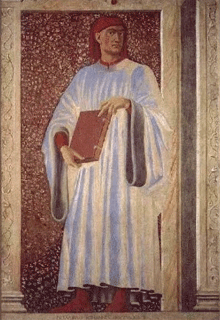| |
For further information about Boccaccio--his writings, his life, his era--you may wish to visit a site maintained by the Italian program at Brown University, the Decameron Web.
Criticism and Biography
Anderson, David. Before the knight's tale: imitation of classical epic in Boccaccio's Teseida. Philadelphia: University of Pennsylvania Press, 1988.
Andrew, Malcolm, Ed. Critical essays on Chaucer's Canterbury tales. Toronto: University of Toronto Press, 1991.
Brand, Peter and Lino Pertile. The Cambridge history of Italian literature. Cambridge: Cambridge University Press, 1996.
Branca, Vittore. Boccaccio: the man and his works. New York: New York University Press, 1976.
Coleman, William E. Watermarks in the manuscripts of Boccaccio's Il Teseida: a catalogue, codicological study and album. Firenze: L. S. Olschki, 1997.
Deligiorgis, Stavros. Narrative intellection in the Decameron. Iowa City: University of Iowa Press, 1975.
Dombroski, Robert S. Critical perspectives on the Decameron. New York: Barnes & Noble, 1977.
Forni, Pier Massimo. Adventures in speech: rhetoric and narration in Boccaccio's Decameron. Philadelphia: University of Pennsylvania Press, 1996.
Ginsberg, Warren. The cast of characters: the representation of personality in ancient and medieval literature. Toronto: University of Toronto Press, 1983.
Hastings, Robert. Nature and reason in the Decameron. Manchester: Manchester University Press, 1975.
Hollander, Robert. Boccaccio's Dante and the shaping force of satire. Ann Arbor: University of Michigan Press, 1997.
-- Boccaccio's two Venuses. New York: Columbia University Press, 1977.
Kirkham, Victoria. The sign of reason in Boccaccio's fiction. Firenze: Leo S. Olschki Editore, 1993.
Koff, Leonard Michael. The Decameron and the Canterbury tales: new essays on an old question. Cranbury, NJ: Associated University Presses, 2000.
Marcus, Millicent Joy. An allegory of form: literary self-consciousness in the Decameron. Saratoga, Calif.: Anma Libri, 1979.
Mazzotta, Giuseppe. The world at play in Boccaccio?s Decameron. Princeton, NJ: Princeton University Press, 1986.
McGregor, James H. The shades of Aeneas: the imitation of Vergil and the history of paganism in Boccaccio's Filostrato, Filocolo, and Teseida. Athens: University of Georgia Press, 1991.
Meltzoff, Stanley. Botticelli, Signorelli and Savonarola : theologia poetica and painting from Boccaccio to Poliziano. Firenze: L.S. Olschki, 1987.
Nissen, Christopher. Ethics of retribution in the Decameron and the late medieval Italian novella: beyond the circle. Lewiston, NY: Mellen University Press, 1993.
Serafini-Sauli, Judith Powers. Giovanni Boccaccio. Boston: Twayne Publishers, 1982.
Smarr, Janet Levarie. Boccaccio and Fiammetta: the narrator as lover. Urbana: University of Illinois Press, 1986.
Stone, Gregory B. The ethics of nature in the Middle Ages: on Boccaccio's poetaphysics. New York: St. Martin's Press, 1998.
Ricketts, Jill M. Visualizing Boccaccio: studies on illustrations of The Decameron, from Giotto to Pasolini. New York: Cambridge University Press, 1997.
Thompson, N. S. Chaucer. Boccaccio, and the debate of love: a comparative study of the Decameron and The Canterbury Tales. Oxford: Oxford University Press, 1996.
Wallace, David. Chaucer and the early writings of Boccaccio. Dover, N.H.: D.S. Brewer, 1985.
Below are two images of Boccaccio:


|



